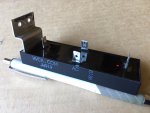Why parallel diodes when you can get a single module that will comfortably handle the current.For the OP... hopefully you googled something like "series and parallel of diodes" and learned why you must try to not do it.
The issue as many have said is that the forward voltage drop will not be the same. You can buy 10 bridge rectifiers and check drop on each of the internal 4 diodes and try to pick a better matched set, but why not just the correct size to begin with? My 7kw generator in my 1973 GMC motorhome has a 25amp continuous bridge rectifier - think I paid like $ 1.50 for it.
The issue continues to a potential snowball effect: as one diode passes more current than its parallel friend, it will heat up. Heating semiconductors causes their forward voltage drop to decrease. So it will then pass evven MORE of the uneven load. Heat up more, draw more of the load, heat up. This snowball effect can overload this diode, blowing it. Now you are back to the single diode that is not rated to pass the full so it will eventually blow.
If this is required to be done, adding L or R in series with the diodes helps match them. Otherwise, as one reply stated where they put bazillions of diodes in parallel for hi power power supplies, they no doubt put then on THE SAME HEASINK - so one did not heat more than it neighbors and the snowball effect did not happen (often probably).
Next issue is WHAT SIZE DO YOU REALLY NEED?? Do you really believe your 480v 22 ohm solenoid will draw 18 amps???? Think about that for a bit. Then go measure some other INDUCTORS and COILS like other small solenoids, any transformers... Your 22 ohms is only a SMALL PORTION OF YOUR SOLENOID's IMPEDANCE! The L in that coil will limit the current!
So before you try to pick the proper diode bridge, why not stick an ammeter in series (or a clamp on) with that solenoid and MEASURE the steady state current! I bet you find it is less than 1 amp! The 22 ohms tells me that it likely will have about a 20x inrush current - or 18 amps.
And, if it's a DC solenoid, there would be no inrush.



